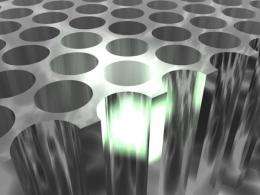New diffraction phenomenon observed and explained

'Sub-Bragg diffraction' is what researchers at the Complex Photonic Systems group of the University of Twente’s MESA+ Institute for Nanotechnology call their surprising observations. An ‘energy dip’ can also occur when reflection takes place in regular crystal structures at ultra-low energy frequencies . Theoretically, the lowest energy at which this can take place has been unshakably fixed for almost a century, as predicted in the so-called Bragg conditions.
“According to this theory, successive diffractions take place which, in turn, lead to energy dips”, researcher Simon Huisman told us. “The striking thing is that this can take place at lower frequencies or energies. And this applies to almost half of all known crystal structures.” The results will be published in Physical Review Letters on 24 February 2012.
In the first instance, the researchers think that the results will be useful in new optical switches which use the ‘forbidden band’. Since light of certain wavelengths – and thus of colours – cannot travel through a crystal because of diffraction, it is possible to switch information-carrying light effectively. According to researcher Huisman, these findings are of value to designers of these circuits. “Apart from the fact that it will be possible to shift the energy levels in a new way – which is already pretty spectacular – there are additional possibilities for shifting the frequencies in particular directions. This has important added value.”
The work is also of direct importance for roentgen microscopy, in which effective use is made of certain light frequencies and Bragg diffraction. Because it is now known that energy gaps can also occur at low frequencies, researchers have to take these diffraction peaks into account too. They might otherwise be falsely led to believe in the presence of specific materials.
The researchers got onto the track of the sub-Bragg phenomenon unexpectedly. Some of the light energy which was locked in a photonic crystal did not actually remain in it permanently but escaped quickly. Crystals have unique diffraction properties which result from their regular periodic structure. The throughput and scattering of energy was described by William Lawrence Bragg, the son of William Henry Bragg (both of whom received the Nobel Prize in 1915): if the wavelength is twice the distance between the nodes (which lie in a plane) of the crystal, then the light of that wavelength is extinguished. This is how an energy gap is caused in the crystal.
Bragg realized, ingeniously, that the energy gaps are determined by the distance between the nodal planes of the atoms or molecules in the crystal lattice. By simulating the nodal planes in silicon with extremely accurately drilled nanoholes (without irregularities, in cleverly chosen patterns), the researchers were able to observe a second diffraction in experiments, originating from planes diagonal to the earlier-known planes. Diffraction also takes place here, and at longer wavelengths of light which correspond with lower frequencies and lower energy.
The light waves are simultaneously reflected by two sets of nodal planes which are related: Bragg and ‘sub-Bragg’ diffraction. Huisman explained that it does not matter whether we are talking about light or sound. Sub-Bragg diffraction occurs in semiconductors but also in roentgen radiation or sound travelling through lattices. “We predict that the phenomenon is just as likely to be found there.”
The energy gaps are essential for the switching of electronic flows and information units in semiconductors, acoustic characteristics within acoustic crystals and the locking up of light in optic metamaterials. Designers can determine how all kinds of waves travel through different materials through their diffraction patterns.
The accurate drilling of the holes was essential for the observations. Two years ago, this was not possible, but these days Mesa+ has state-of-the-art equipment. The patterns do not show any irregularities. “That is an absolute condition for the observation, because scattering clouds the results irreparably.”
In many cases, Sub-Bragg diffraction has implications: in two of the five two-dimensional Bravais crystal structures and in seven of the fourteen three-dimensional Bravais structures. These classifications tell us about the way in which the nodes are distributed over the planes. Huisman continued: “Our experiments could just as well have been carried out with square holes. The shape is not important. What is important is the specific repetition and spatial distribution of the lattice points.”
Journal information: Physical Review Letters
Provided by University of Twente



















